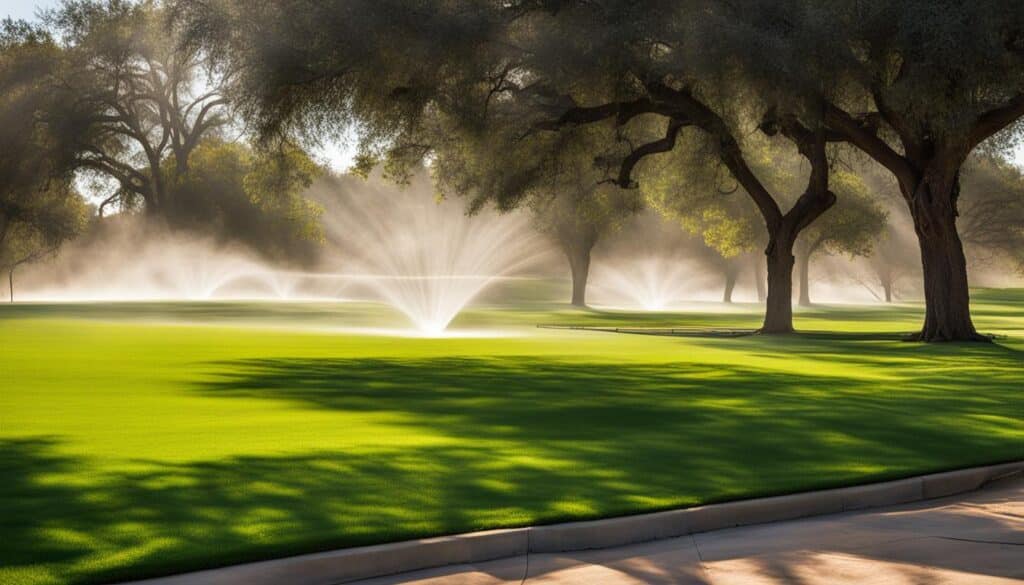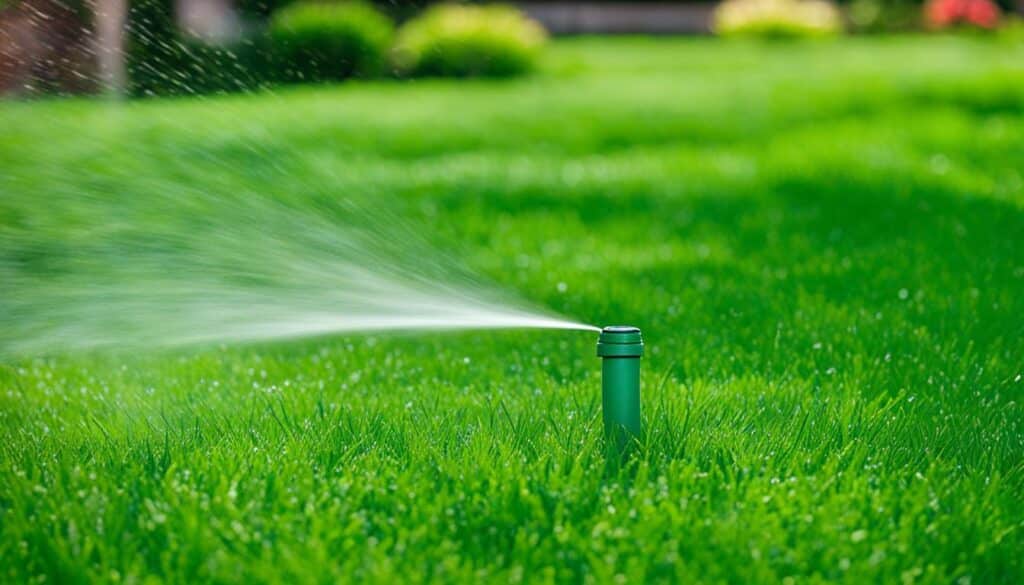Are you wondering how long your sprinklers should run in Texas? Finding the optimal irrigation length for Texas lawns can sometimes be a tricky task. Factors such as soil type and the slope of your yard can affect the recommended watering duration. But don’t worry, I’m here to help!
As a professional copywriting journalist, I’ve done the research to provide you with the answers you need. Whether you’re in Frisco or any other city in Texas, the guidelines I’m about to share will help you keep your lawn healthy and thriving.
Watering Guidelines for Texas Gardens
When it comes to watering gardens in Texas, it is important to follow guidelines to ensure efficient water use. The key to a healthy garden is finding the right balance in sprinkler run times to provide adequate hydration without wasting water. Let’s explore some watering guidelines for Texas gardens.
Testing Run Times
Each garden is unique, with different plant types and soil conditions. Therefore, it is important to test the run times for each sprinkler zone and adjust accordingly. Start by running each zone for a specific amount of time and then observe how the plants respond. If the soil becomes overly saturated or there is runoff, it may be a sign of excessive watering. On the other hand, if the soil remains dry or the plants wilt, you may need to increase the run time to ensure proper hydration.
Preventing Runoff
One of the main challenges in garden irrigation is preventing runoff. This can be achieved by using the cycle and soak method. Rather than running the sprinklers continuously for a long period, divide the total irrigation time into two or three parts. Schedule the run times about one hour apart, allowing the soil to absorb the water effectively. This approach helps prevent water from running off and promotes deep root growth, leading to healthier plants.
Remember, timing is crucial when it comes to garden watering. To minimize water evaporation and allow excess water to dry before nightfall, it is recommended to water your garden between 5AM and 10AM. This timeframe also reduces the risk of fungal lawn diseases, as the foliage has time to dry out during the day.
Optimal Watering Duration for Different Seasons in Texas
When it comes to determining the ideal watering duration for different seasons in Texas, there are a few key factors to consider. The changing weather conditions, temperature, and precipitation levels all play a role in determining the best practices for sprinkler run time. By adjusting your watering schedule based on these factors, you can ensure efficient water use and maintain the health of your lawn and garden.
In the spring, as lawns and landscaping come out of winter dormancy, less water is typically needed. It’s important to reduce the watering duration and frequency during this season. As the heat intensifies during the summer months, it becomes crucial to strike a balance between watering enough to keep the lawn healthy and conserving water. Specific grass types, such as Bermuda grass, St. Augustine, and Zoysiagrass, have their own watering requirements. Therefore, it’s important to adjust the run times accordingly for different sprinkler heads.
As the fall season approaches and temperatures start to cool down, the watering schedule can be adjusted once again. Generally, less water is needed compared to the summer months, as plants enter a state of dormancy. However, it is advisable to monitor weather conditions and adjust accordingly to prevent under-watering or over-watering. By adapting your watering duration to the changing seasons, you can ensure that your lawn and garden receive the optimal amount of water for their specific needs.
Benefits of Adjusting Watering Duration for Different Seasons
Adhering to the ideal watering duration based on the season provides several benefits for your lawn and garden. Firstly, it promotes the health and vitality of the plants by ensuring they receive the right amount of water when needed. Secondly, it helps conserve water by avoiding over-watering or watering during periods of rainfall. Lastly, adjusting the watering duration based on the changing seasons helps prevent issues such as fungal diseases and pest infestations, as the plants are less susceptible to these problems when they are in their optimal growing conditions.
Tips for Efficient Lawn Watering in Dallas
When it comes to maintaining a healthy lawn in Dallas, efficient water use is key. By following these watering guidelines, you can ensure that your lawn stays green and vibrant while conserving water.
Check Soil Moisture Levels
Before watering your lawn, it’s important to check the soil moisture levels to determine if watering is necessary. You can use a soil moisture meter or a simple tool like a screwdriver. Insert the screwdriver into the soil, and if it goes in easily and comes out damp, your lawn doesn’t need watering. If the soil is dry, it’s time to water.
Water During the Optimal Time
The best time to water your lawn in Dallas is between 5AM and 10AM. Watering during this time minimizes evaporation and allows excess water to dry before nightfall, reducing the risk of lawn diseases and pest infestations. Avoid watering in the evening or at night, as this can promote fungal growth.
Measure the Amount of Water
It’s helpful to measure the amount of water your lawn is receiving to ensure you’re using the right amount. You can do this by placing empty tuna cans or other containers throughout your lawn and measuring the water level after each watering session. Adjust your watering schedule based on the results to prevent overwatering or underwatering.
By following these tips for efficient lawn watering in Dallas, you can promote a healthy lawn while conserving water. Remember to check soil moisture levels, water during the optimal time, and measure the amount of water your lawn is receiving. With proper care and attention, your lawn will thrive even in the unique climate of Dallas.
Conclusion
Proper watering of sprinklers in Texas is crucial for maintaining healthy lawns and gardens. By following the recommended guidelines and adjusting the watering duration based on factors such as soil type, slope, and weather conditions, homeowners can ensure efficient water use and promote deep root growth.
It is important to avoid overwatering and to check soil moisture levels to determine when watering is necessary. Overwatering can lead to issues such as fungal growth and weak roots. Checking soil moisture levels using tools like soil moisture meters or a simple screwdriver can help determine if watering is needed.
With proper care and attention to watering practices, Texas lawns and gardens can thrive even in the unique climate of the state. By maintaining a balance between watering enough to keep plants healthy and conserving water, homeowners can create beautiful landscapes while also being mindful of the environment.
FAQ
How long should sprinklers run in Texas?
The recommended watering duration for sprinklers in Texas varies depending on factors such as soil type and slope of the yard. In Frisco, Texas, for example, the city advises using the cycle and soak method, which involves running each sprinkler zone for the amount of time that the soil can absorb. For clay soil in Frisco, this typically means running a spray zone for no more than six minutes. It is recommended to split the total irrigation time into two or three parts and schedule the run times about one hour apart until the soil is moistened to a depth of 6 to 8 inches. This method helps prevent runoff and promotes deep root growth for the plants.
What are the watering guidelines for Texas gardens?
When it comes to watering gardens in Texas, it is important to follow guidelines to ensure efficient water use. The Frisco city advises using the cycle and soak method mentioned earlier for lawns, but the recommended run times may vary depending on the specific needs of the plants in the garden. It is recommended to test the run times for each zone and adjust accordingly to prevent runoff. Additionally, it is important to water gardens between 5AM and 10AM to minimize water evaporation and allow excess water to dry before nightfall, reducing the risk of fungal lawn diseases.
What is the optimal watering duration for different seasons in Texas?
The optimal watering duration for different seasons in Texas depends on factors such as temperature and precipitation. During the spring, as lawns and landscaping come out of winter dormancy, less water is typically needed. Sprinkler run times can be adjusted accordingly, with recommendations varying based on the type of sprinkler system and the specific grass type. In the summer, when the heat is at its peak, it is important to maintain a balance between watering enough to keep the lawn healthy and conserving water. It is recommended to water Bermuda grass, St. Augustine, and Zoysiagrass twice a week, with specific run times for different sprinkler heads. During the fall, the watering schedule can be adjusted again to accommodate changing weather conditions, with less water generally needed compared to the summer.
What are some tips for efficient lawn watering in Dallas?
To ensure efficient water use for sprinklers in Dallas, there are several tips to keep in mind. It is important to avoid overwatering, as this can lead to issues such as fungal growth and weak roots. Checking soil moisture levels using soil moisture meters or simple tools like a screwdriver can help determine if watering is necessary. Watering should be done when there is gentle wind to prevent water droplets from being blown away. The best time to water lawns in Dallas is between 5AM and 10AM to minimize evaporation and reduce the risk of lawn diseases and pest infestations. It is also recommended to measure the amount of water your lawn receives using a watering yardstick and tuna cans, adjusting the watering schedule based on the results.








